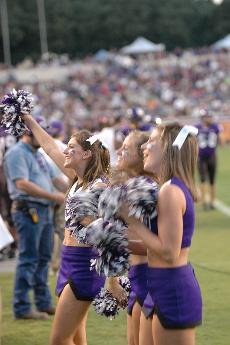Injuries on the football field are expected, but the sport on the sidelines has been shown to be riskier than you might think.
A new study spanning dates from 1982 to 2007 shows that cheerleading tops the field in severe school sports injuries for female athletes in high school and college, according to the University of North Carolina’s National Center for Catastrophic Sport Injury Research.
The group’s Web site defines catastrophic injury as a “sports injury that resulted in a brain or spinal cord injury or skull or spinal fracture.” Direct injuries are defined in the study as injuries that result from participation in the sport and not indirect factors like health complications.
Over the past 25 years, cheerleading accounted for 70 catastrophic injuries – 63 direct and seven indirect injuries – followed by basketball with 19 catastrophic injuries, according to the report. Catastrophic injuries to female athletes have increased over the years, and a major factor in this increase has been the change in cheerleading activity, which now involves gymnastic type stunts, according to the study.
Scott Kull, associate athletics director for external operations, said TCU has implemented parameters to ensure the cheerleaders’ safety.
“I don’t know what programs have had catastrophic injuries and which have not, but my assumption would be that they are related to cheerleaders being tossed in the air, and we don’t do that,” Kull said.
Kull said he would tell TCU parents or guardians concerned about those who participate in the sport that the team’s coach, Lindsay Shoulders, is certified to be a cheerleading instructor and that TCU doesn’t allow cheerleaders to be thrown into the air.
“We can have an athlete or a cheerleader standing on someone’s shoulders but they’re not to be tossed in the air,” Kull said.
Lacey Truncale, a junior nursing major and former TCU cheerleader, said that training and knowing the limits of her abilities was what kept her from getting hurt.
Truncale said the squad was allowed to do pyramids, but not tosses. She said competition was different.
“If you aren’t trained and you go out there and try to do something you have not been spotted on and learned very gradually, and become familiar with your body and the air while tumbling, you could really hurt yourself,” said Truncale, who cheered for TCU as a freshman, but said she quit because of the increasing workload of her nursing major. “It’s also a lot about trust, too. If you’re a flier, you have to trust your base.”
Truncale said she was involved in gymnastics and ballet since she was 4 years old. She said she cheered from middle school through high school and has torn ligaments in both of her ankles, which she said are still swollen. She said she has fractured her arm and has heard about long-term effects, like arthritis, from past coaches with years of landing on their joints behind them, but nothing she considers serious, like a catastrophic injury.
Despite the risk of future health complications, Truncale still looks back on her cheerleading career with a smile.
“It was fun and I always liked to be down on the field and part of the game,” Truncale said.
TCU athletic media relations denied contact with Shoulders and current cheerleaders.

